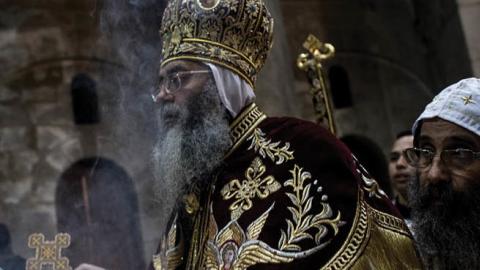On the night of January 6, millions of Copts worldwide flocked to their churches to celebrate the Nativity liturgy just as they had done for centuries. This year, however, for a few of them something must have seemed odd or rather too repetitive. For just 13 days earlier, on the eve of December 25, some of them had witnessed the same event. The first of its kind event has created a firestorm in their church.
It all started with a letter:
Therefore, to respond to the pastoral needs and concerns of those faithful members of the Church, it is permitted for our parish churches, on condition that there is pastoral need, to have ADDITIONAL celebration of the Feast, starting with Vespers and Midnight Praise on the evening of 24 December, and Matins and Eucharistic liturgy according to the rite of the Nativity Feast on the morning of December 25 without breaking the Advent fast.
The words were not supposed to go public. They were written in a private letter from Anba Serapion, the Coptic Metropolitan of Los Angeles and Southern California to priests in his diocese. In fact, the letter went to extended lengths to emphasize this was not meant to change the date the Coptic Church celebrates the birth of Christ. “This is to confirm that our celebration of the Feast of the Nativity is and will always be on 29 Kiahk (7 January); additional celebration on 28 Kiahk in leap years like 1736,” the letter began. But His Eminence’s careful reassurance would matter little as the letter made its way to social media, leading to heated debates and accusations in a church being torn apart over questions of orthodoxy and change.
For nearly 2,000 years, the Coptic Church has always celebrated Christmas on the 29th of the month of Kiahk. For over 1,500 years, the date concurred with the 25th of December as the entire Christian world followed the Julian calendar. This changed with the introduction of the Gregorian calendar in 1582, which added ten days to the existing Julian one. Over the next four centuries, three more days were added, resulting in the current difference of 13 days between December 25 and January 7. At first, only Catholic-majority countries followed the pope’s revision, but by the mid-eighteenth-century Protestant-majority countries followed suit. With the United Kingdom adopting it in 1752, the calendar became a universal one.
Orthodox-majority countries proved more resistant. Bulgaria only changed in 1916, Russia and Romania in 1918, and Greece in 1923. But while the states adapted to reality, many Orthodox churches refused. Today, the Russian, Georgian, Ukrainian, Serbian, and Jerusalem Orthodox Churches still use the old calendar. Moreover, the adoption of the Gregorian calendar by the patriarch of Constantinople and Orthodox churches in Greece, Romania, and Bulgaria resulted in schisms with Old Calendarist rebellious churches emerging in those countries.
To the modern reader’s eye, fights over the question of the date of Christmas and the accurate calendar seem ridiculous. After all, any serious person would recognize that, on the one hand, we have no way of knowing the precise date of Jesus’ birth and, on the other, it does not actually matter. The Feast of the Nativity, as a celebration of the incarnation of the Word, is a celebration of a divine event outside time. Moreover, matters of time calculation hardly have any ecclesial ramifications and are best left for scientists. But, as observers of church dynamics can attest, what is worldly can easily be turned into a divine matter, and a calendar can become a matter of dogma.
But Pope Tawadros II fired the first shot in the Coptic Church’s calendar debate several years ago. During a visit to churches in Canada, the pope suggested the Coptic Church would change the date of Christmas to align with the vast majority of Christians celebrating on December 25. The suggestion and the mindset behind it were quintessential Tawadros, whose approach is quite different from his predecessor’s, Pope Shenouda III, who maintained cordial relations with Western churches, paying lip service to the ecumenical movement and dreams of Christian unity, but had throughout his reign stressed Coptic exclusivity, strengthening both the community’s sense of itself and its isolation from the rest of Christianity. Yet Pope Tawadros came to the papacy with a strong belief in both uniting the body of Christ, reforming the Coptic Church, and adapting to changing times.
While much attention has been given to the pope’s involvement in political affairs and support for the Abdel Fattah el-Sisi regime in Egypt, Tawadros has led an internal revolution inside the Coptic Church. He launched a much-needed reorganization of the Church’s administration, decentralizing the huge power structure Pope Shenouda built around himself. Tawadros also opened up the Church to different Coptic schools of thought and theology, from that of the late Father Matthew the Poor to the late Bishop Samuel, two men and visions Pope Shenouda spent his papacy trying to wipe from memory. But perhaps most importantly, the current pope has shown his commitment to ecumenical relations.
Immediately after his enthronement, Pope Tawadros initiated the Egyptian Churches Council, which gathered all the main Christian denominations under one roof. The growing threat posed by the Muslim Brotherhood’s rule certainly played a role in pushing for unified action, though the council’s mission was solely religious. In an unprecedented step, the pope attended the enthronement of a new Coptic Catholic patriarch in March 2013. Two months later he took his first foreign trip to the Vatican to meet Pope Francis and declare his hope for uniting the two historical pillars of Christianity. He also suggested unifying the dates of Christmas and Easter. The two popes developed a close personal relationship, with each agreeing to pray for the other daily. In April 2017, Pope Francis visited Egypt, and the two popes planned to issue a historical declaration canceling rebaptisms of Catholics who join the Coptic Church. While on the surface the issue would affect very few people inside Egypt, the move meant something bigger, that for the first time since the Council of Chalcedon in 451, the Coptic Church would recognize the Catholic Church as an apostolic and authentic church.
But like his effort to unify the dates of Christmas and Easter, Pope Tawadros’ attempts to revoke rebaptisms faced a huge backlash and ultimately failed. While his reform program faced resistance within the Holy Synod from old guard bishops, it was the latter’s success in mobilizing Copts through social media that proved the death knell for the pope’s reform program until now. This strategy has been employed since Pope Tawadros’ enthronement. Facebook groups under names such as Defenders of the Faith, Sons of Pope Shenouda, the Orthodox Rock, and tens of others were established, often by the same people.
There was no shortage of stories. The pope used a new method to cook the chrism; he allowed “heretics” to teach in the Church; a bishop taught that the story of Adam was written in a mythological style. The details of each story were irrelevant. What mattered for those Facebook pages and the bishop funding them was the overall impression they created and the message they sent, sometimes subtly and sometimes crudely: the Coptic faith was under threat, and the culprit was the pope.
But as important as the ongoing battle inside the Coptic Church in Egypt is, another one holds a graver potential for the Church’s future: its relationship with the Coptic diaspora. For nearly 2,000 years, Egypt and Copts were synonyms. This changed, first slowly in the 1950s as the first Copts emigrated to the West, and then as a never-ending tsunami of Coptic emigrants. Today about one million Copts living in permanent emigration in the West, and they include tens of thousands of second and third generation Copts. For those young Copts, Egypt and its sorrows are a distant tale. If the Coptic Church has any hope in keeping them, it will inevitably make the transition from a national church tied to a particular land to a truly universal church that today stretches from Sweden to South Africa and from the United States to Japan.
This year two Nativity liturgies were celebrated in one diocese. For those worried about the Church’s future, the question is not that of a Christmas date or necessary adjustments for pastoral needs, but rather whether years from now we may look back at this decision as the first step in a painful schism that separates the Coptic Church in Egypt from its churches in the West, a separation of the daughter from the mother.
Read in Providence

















